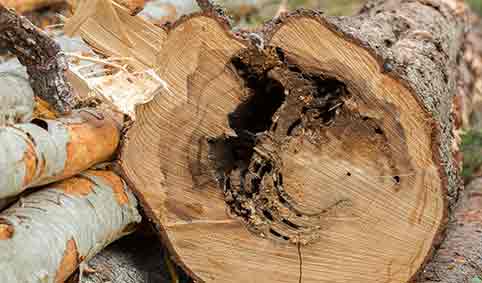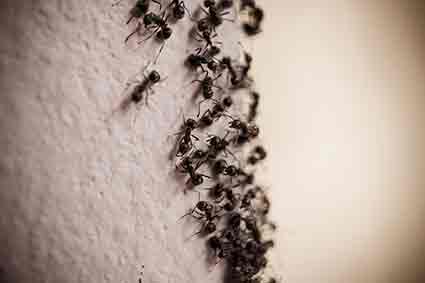Carpenter Ants are notorious for severely damaging homes in New York. These creatures destroy wood by tunneling and nesting inside leaving many homeowners trying to figure out how to kill Carpenter Ants. Even though they do not consume the wood, they burrow through it, leaving behind a sawdust-like substance known as frass.
If these ants are left alone, they can develop a network of tunnels in the wood in your house’s walls and roofing, compromising its structural integrity. Therefore, if you detect any signs of Carpenter Ants infestation in your premises, you must take fast action to ensure that you eliminate them immediately. Let’s go over a few ways you can use to get rid of Carpenter Ants from your residence.
Find the Nest First
The most effective way of killing the Carpenter Ants is locating and treating their nests directly. Since these pests love burrowing in moist and decaying wood, following their trail can lead you to their colonies. The most daunting task is to determine whether the nest is located indoors or outdoors. Once you identify where the ants call home, you can now use any of the following methods to get rid of them.
Methods of Killing Carpenter Ants
How To Kill Carpenter Ants – Step 1: Indoor Treatment
Indoor Baiting:
If you have seen the Carpenter Ants trail but can’t access their nest, the best method to eliminate these insects is baiting. There are vast solutions in the market that you can use to bait Carpenter Ants. Be sure to check where you are applying these materials. The placement of ant bait is just as important as the product itself.
If you like the natural way, you can create a homemade bait by mixing equal parts of baking soda and sugar. The bait attracts the Carpenter Ants, and when they touch it, they get poisoned and die after a few minutes. The bait is placed near an ant activity or next to their trail. Placing it in the middle of their path can make the insects avoid it and render it ineffective. Examples of places where you can position your bait are:
- Next to sinks and drains
- Under or behind bathroom fixtures
- On countertops or in kitchen cabinets
- Around cords, pipes, and cables that extend to the outside
- On window and door frames
The Carpenter Ant bait should be checked once a week and replenished until the ant activities in your premise cease.
Spray Cracks and Crevices
Spraying is another method that you can use to ensure that Carpenter Ants leave your home once and for all. The best thing about spraying is that you can use it to supplement baiting. The main reasons why sprays are used together with baits are:
Sometimes the ants ignore the bait since they already have enough food resources. Baits are ideal for places that can’t be sprayed with insecticides, such as kitchen cabinets or other food storage facilities.
Experts recommend that you use non-repellent sprays since they are undetectable, and the ants can easily pick them on the trail and carry them back to the nest. Although non-repellent sprays take time before they start killing the insects, they allow the worker Carpenter Ants to spread the insecticide throughout their colony, thereby eliminating more of them.
The sprays can be applied using the straw applicator or sprayed directly into the crevices and cracks on the walls, under appliances, along baseboards, and around door and window frames.
Direct Nest Treatment
If you are sure where the Carpenter Ants’ nest is, you can directly treat them using various insecticides. For nests located in the wall, you can open up the wall or drill holes that expose the colonies and use either foams or dust insecticides to exterminate the entire colony.
Killing Carpenter Ants Using Dusts Insecticides
Get an insecticide that is designed for Carpenter Ants and apply it to the infected parts. Using a hand duster, direct the insecticide into the void on the wall or the beam. Using dust is preferred since it kills the insects faster than the other methods, and some pesticides will drive the ants to pick up the eggs and move to another location. DO NOT SPRAY A CARPENTER ANT COLONY UNTIL YOU SPEAK WITH A PROFESSIONAL CARPENTER ANT EXTERMINATOR. You could make the issue worse or more challenging to resolve if you spray the wrong product and they pick up and move the colony.
Killing Carpenter Ants Using Foams
There are plenty of ready-to-use foam products that you can use to kill Carpenter Ants. They boast a flexible hose and nozzle that fit in many areas, whether in tiny holes or cracks on the wall. You can either choose to go for repellent or non-repellent foams, depending on how quickly you want to get rid of the ants.
How To Kill Carpenter Ants – Step 2: Outdoor Treatment

Once you are sure that all Carpenter Ants in your house have been dealt with, it’s now time to take care of the outdoor area. Since Carpenter Ants can nest everywhere, outdoor treatment is essential.
Outdoor Baiting
If you are always seeing Carpenter Ants crawling around your house, you can bait the insects to eliminate them from your premises. Like indoor treatment, you can use baits such as a Borax solution or Ficam in the exteriors. You can place it next to the ants’ trail or where you see the insects wandering.
Make sure you combine sprays with baits so that you can kill ants that hunt for food as well as those that remain in the nest. Non-repellent sprays are preferred since they don’t repel or get noticed by the pests. They are sticky and don’t kill the insects instantly. For this reason, worker Carpenter Ants will carry them back to the nest and infect other members of the colony.
Direct Nest Treatment
For Carpenter Ant nests located outdoors, you can go ahead and kill the ants directly using dust and foam insecticides. You can also use a broad-spectrum insecticide that boasts a residual effect that continues to kill the insects for up to 90 days.
How To Get Rid Of Carpenter Ants So They Don’t Return?
- Seal any leaking pipes or faucets in your home and replace any moisture-damaged wood
- Get of stumps, logs or wood remains in your yard
- Trim the vegetation around your house, including branches that touch your home
- Ensure that areas around your foundation, landscaped areas, and lawns are sprayed with insect killer granules
- Apply Bora-care to untreated wood surfaces to prevent future infestation of carpenter ants and termites





